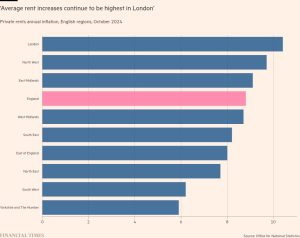Why retrofuturism looks so now
Unlock the Editor’s Digest for free
Roula Khalaf, Editor of the FT, selects her favourite stories in this weekly newsletter.
“The future almost never unfolds in the way that everyone expects,” says Joseph Grima. The architect and co-founder of the Milanese design platform Alcova is also curator of the Paimio Sanatorium, a tuberculosis treatment centre that was completed in 1933 by Finnish architects Alvar and Aino Aalto at a time when Finland was newly severed from Russian rule. The space was conceived as a response to a pandemic: its concrete form, acid-yellow corridors and bentwood furniture marked the realisation of a future-facing vision centred around care.


Paimio didn’t quite achieve its full, original purpose. In the ’60s, it became a general hospital and a rehabilitation centre and is now a design destination, with overnight stays. But the space still encapsulates a sense of hope and positivity that resonates, even if distantly, today. “Modernist designers such as the Aaltos are pioneers,” says Grima. “They show how architecture can be an instrument for championing collective ideals. It’s inspiring and part of the human spirit to look at the world and think about how it could be better.”
Despite modernism’s democratic principles, its aesthetic often found its fullest expression in private homes where wealthy patrons gave architects and designers creative freedom. “America is dotted with crazy modernist mansions created to fulfil a childhood fantasy,” says Grima, pointing to Le Corbusier’s “machine for living” Villa Savoye, and Richard Neutra’s Lovell Health House. “They remain some of our most revered buildings.” This exchange continues: a cursory glance through Michael Webb’s latest book California Houses – a tour around 36 recently conceived private dwellings that cleverly move the midcentury modernist needle without reinventing the wheel – attests to the sticky allure of these early-20th-century templates.

Why do designers and architects still look back at these past-future visions to propel creativity today? The age of modernism may have come to an end, says Grima, but rather than being replaced by a formal design movement, today’s urban space is held within the clutches of market forces and building regulations. “It’s become very difficult to position yourself aesthetically as an architect. We live in a moment when we’re in dire need of the grand visions we were offered in the past. Such retrofuturism is more relevant than ever.”
Retro Icons

Eero Aarnio fibreglass Ball chair, €7,682

Ligne Roset fabric Pumpkin small settee by Pierre Paulin, from £1,741

Aram tulip chair by Eero Saarinen, from £1,399

Stilnovo MiniTopo table lamp by Joe Colombo, £290, artemest.com

Cappellini Tube chair by Joe Colombo, £2,770, artemest.com

Nilufar Editions Skeleton and Flesh cabinet by Khaled el Mays, POA
The Oxford English Dictionary defines retrofuturism as “the use of a style or aesthetic considered futuristic in an earlier era”. It’s a term that first arose in academia and advertising circles in the mid to late 20th century. In Retro: The Culture Of Revival, Elizabeth E Guffey explains its paradoxical meaning as “the discrepancy between what the future once represented and what it no longer means”. Its 1970s rise marked the beginning of a disenchantment with the power of technology. “Although man had landed on the Moon, daily life remained banal,” she writes.
“Retrofuturism has an optimism, but it also comes from a place of acknowledgement of failure,” says Alex Tieghi-Walker of Manhattan’s Tiwa Gallery. He points to the idealism of Californian hippies, dreamers who envisaged a return to nature – an idealism that is partly reflected in the artisanal approach of many of the artists and designers the gallery represents.
Whether in architecture, product creation or interior decoration, designers are finding solace in their visions of tomorrow. “In my profession, nostalgia is the key word,” observes interior designer India Mahdavi, whose Paris practice features a showspace called Project Room for creatives. “There’s a whole tendency for designers to try to reproduce something from the past.”
On a recent trip to New York, Mahdavi noticed a poster on the street that read: “Nostalgia is killing the future”. It triggered something in her. “We are so much already in the future with AI, and all the technology that’s available, we feel that we need to go backwards, as that’s what we know – and that’s what’s comforting.” Mahdavi explores familiar forms in her own practice as a way to provide “visual and emotional comfort”. The key, she says, is to present the past in more innovative ways.
“Retrofuturism offers a sense of optimism and creativity that feels particularly safe,” agrees Nina Yashar of Milan’s Nilufar Gallery, which was founded in 1979. “It’s a captivating blend of nostalgia and forward-thinking imagination that gives rise to sleek, streamlined forms, vibrant colours and bold, imaginative shapes. It’s a fusion of midcentury modern design with futuristic elements featuring chrome, glass and innovative materials.” This finds expression in the work of everyone from Marc Newson to disruptor Khaled El Mays, a designer-architect living between Athens and Beirut, who constructs imaginary digital environments for his otherworldly furniture creations.

Social media has also played a role in the proliferation of yesterday’s retrofuturism. For Dan Thawley, a writer, consultant and creative director of Parisian design salon Matter and Shape, “Tumblr and Instagram prompted a rediscovery of all these different periods,” which has given rise to the revival of everything from the Sottsass Ultrafragola Mirror to the Alessi cheese graters and corkscrews to that retrofuturist staple – conversation pits.
“Design in the mid-20th century looked forward not only in terms of aesthetics but also production,” continues Thawley. “Materiality is a much more important part of the design process today. Both industry and consumers want to know where pieces are sourced – their provenance. But the retrofuturistic principles of modularity, lightness, stackability and multi-use live on.”
In architectural terms, says the author and architect Reinier De Graaf, who is a partner at OMA, predicting the future is about pure creative thinking – not accuracy. “When you dig into the predictions from the late 19th century and 20th century you almost become nostalgic for times that were less nostalgic than our own.” When exploring past predictions he discovered that those outside a particular industry were the best at speculative thinking – for instance, while IBM pooh-poohed home computers, Stanley Kubrick’s 2001: A Space Odyssey anteceded touch-screen tablets by some 40 years. “The nice thing,” says De Graaf, “is that imagination, when presented in a compelling enough way, becomes a self-fulfilling prophecy.”
#retrofuturism







